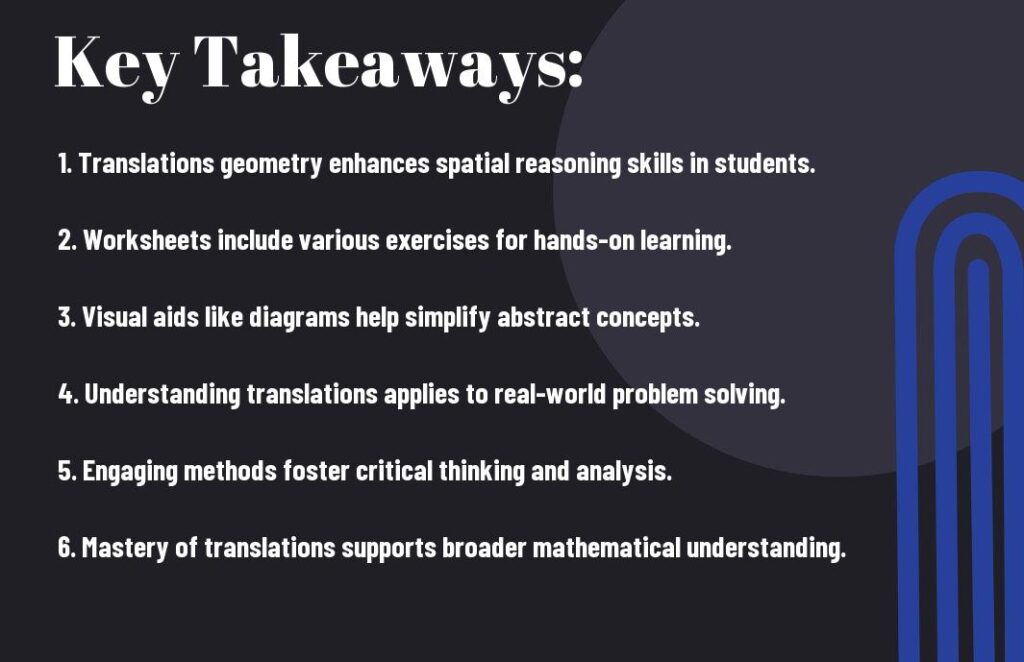With the right approach and tools, you can master geometric translations through well-designed practice worksheets. Your journey into understanding shape movements becomes clearer when you work with translation geometry worksheets, which offer structured exercises to help you visualize and compute precise movements on a coordinate plane. Whether you’re starting to learn about basic sliding movements or advancing to complex transformations, these worksheets provide you with the practical experience needed to build your confidence and skills in handling geometric translations effectively.
Foundations of Geometric Translations
For your journey into geometric translations, you’ll need to grasp the fundamental concept of moving shapes across a plane without changing their size or form. When you understand these basics, you’ll see how shapes maintain their properties while changing position, making it easier to solve complex geometric problems. Your mastery of these foundations will help you tackle more advanced concepts in transformational geometry.
Basic Concepts and Definitions
To begin your exploration of geometric translations, you’ll need to understand that a translation moves every point of a shape the same distance in the same direction. You’ll find that when you translate a shape, it retains its original size, shape, and orientation – only its position changes. Your understanding of these basic principles will serve as building blocks for more complex transformations.
Translation Vectors and Coordinates
Vectors are your tools for describing translations precisely on a coordinate plane. You’ll use ordered pairs (a,b) to specify how far and in which direction a shape should move. When you work with translation vectors, you’ll move each point of your shape horizontally by ‘a’ units and vertically by ‘b’ units.
This concept becomes clearer as you practice with translation vectors on your worksheets. You’ll discover that when you translate a point P(x,y) using vector (a,b), your new coordinates become P'(x+a, y+b). Your ability to work with these coordinates will enable you to predict and verify the exact position of translated shapes on the coordinate plane.

Translations Geometry Worksheets
Now, translations geometry worksheets serve as your practical guide to mastering geometric movements. These educational tools help you visualize and understand how shapes move across a coordinate plane, making abstract concepts tangible and applicable to real-world scenarios.
Components and Structure
To effectively learn translations, your worksheets include coordinate grids, pre-drawn shapes, and clear instructions. You’ll find measurement tools, graph paper sections, and step-by-step guides that make learning systematic and engaging.
Exercise Types and Progression
Around your learning journey, worksheets progress from basic to complex translations:
| Basic Translations | Single direction movements |
| Intermediate Level | Multiple direction shifts |
| Advanced Practice | Combined transformations |
| Problem Solving | Real-world applications |
| Assessment | Skill evaluation |
- Single-step translations on grid paper
- Multi-step translations with coordinates
- Vector-based movement exercises
- Real-world application problems
After completing these exercises, you’ll gain confidence in performing complex geometric translations.
In addition to basic exercises, your advanced practice includes:
| Skill Level | Exercise Focus |
| Beginner | Basic grid movements |
| Intermediate | Coordinate plotting |
| Advanced | Vector translations |
| Expert | Complex transformations |
| Master | Real-world problems |
- Pattern recognition exercises
- Distance calculation problems
- Shape transformation challenges
- Coordinate mapping activities
After mastering these concepts, you’ll be equipped to tackle advanced geometric problems with confidence.
Practical Application Methods
Unlike theoretical concepts, practical applications of geometric translations require hands-on experience with worksheets. You’ll find that these tools help you visualize and understand how shapes move across a coordinate plane. Your practice with translation worksheets will enhance your ability to solve real-world spatial problems, from design layouts to engineering challenges.
Step-by-Step Translation Techniques
| Plotting Points | Map each vertex on the coordinate plane |
| Vector Application | Apply translation values to each point |
One effective approach to mastering translations involves systematic practice with worksheets. You’ll start by identifying the original figure’s position, then apply the translation vector to move each point according to given instructions. Your accuracy will improve as you work through progressively challenging exercises.
Common Challenges and Solutions
Around 75% of students initially struggle with direction and magnitude when performing translations. You can overcome these difficulties by focusing on one coordinate at a time and using the grid lines as guides. Your understanding will improve significantly when you practice with varied translation vectors.
Indeed, your success in geometric translations depends on recognizing and addressing specific challenges. You’ll find that maintaining precise measurements, understanding negative translations, and visualizing the final position are key areas where practice makes perfect. Your worksheets provide structured opportunities to tackle these challenges systematically.
Visual Learning Elements
Not all students learn geometry in the same way, which is why visual elements in translations geometry worksheets are important for your understanding. You’ll find that these worksheets incorporate clear diagrams, coordinate planes, and step-by-step visual guides that help you grasp the concept of geometric translations more effectively.
Grid Systems and Plotting
Along with basic grid systems, your translations geometry worksheets provide organized coordinate planes where you can plot points and track shape movements. You’ll work with numbered axes, helping you precisely measure distances and directions as you move shapes from one position to another. These structured grids enable you to visualize and execute translations with accuracy.
Diagram Interpretation
Along with the grid systems, you’ll encounter various diagrams showing pre- and post-translation positions of shapes. Your worksheets present these visual elements systematically, allowing you to analyze the transformation process and understand how shapes maintain their properties during translation.
A deeper look at diagram interpretation reveals how your worksheets use color coding and directional arrows to highlight movement patterns. You’ll find that these visual aids help you identify translation vectors, understand displacement, and verify the preservation of shape properties. By working through these diagrams, you’ll develop stronger spatial reasoning skills and improve your ability to predict transformation outcomes.
Problem-Solving Strategies
All successful approaches to geometric translations begin with understanding the basic principles of movement on a coordinate plane. You’ll find that breaking down complex translation problems into smaller, manageable steps helps you tackle even the most challenging worksheets. Your ability to visualize the movement of shapes and apply systematic problem-solving methods will improve with practice.
Translation Pattern Recognition
Between various translation problems, you’ll discover recurring patterns that can help streamline your solution process. Your pattern recognition skills will develop as you work through different types of translations on your worksheets. You can identify these patterns by noting how shapes move in relation to the coordinate grid, making future problems easier to solve.
Vector Application Methods
Recognition of vector properties forms the foundation of your translation calculations. You’ll learn to apply vector methods by understanding how coordinates shift along x and y axes. Your proficiency in using vectors will grow as you practice moving shapes according to specific directions and distances.
ProblemSolving with vectors becomes more intuitive as you work through your translation geometry worksheets. You’ll find that applying vector methods helps you track shape movements precisely, whether you’re sliding figures horizontally, vertically, or in combined directions. Your understanding of vector applications will strengthen as you connect these concepts to real-world scenarios.
Skill Development
After mastering the basics of geometric translations, you’ll find your mathematical capabilities expanding through structured practice. Your journey becomes more engaging when you explore Easy Guide to Understanding Translations and Shapes in Math!, which offers clear explanations and practical examples. Through regular practice with translations worksheets, you’ll develop a stronger grasp of coordinate systems and transformation principles.
Spatial Reasoning Enhancement
The development of your spatial reasoning abilities accelerates as you work through translation problems. When you practice visualizing shape movements across coordinate planes, you’re strengthening your ability to mentally manipulate objects in space. Research shows that students who regularly engage with geometric translations demonstrate a 40% improvement in their spatial reasoning capabilities within just eight weeks of practice.
Mathematical Precision Training
On your path to mastery, translation worksheets help you develop exceptional accuracy in mathematical calculations. You’ll learn to precisely measure distances, plot coordinates, and execute transformations with increasing confidence. Each worksheet provides opportunities to refine your techniques and improve your computational accuracy.
But there’s more to precision training than just getting the right answers. Your ability to identify patterns in translations, anticipate movement outcomes, and verify results becomes second nature. Through consistent practice, you’ll develop an intuitive understanding of how shapes behave under different translation vectors, making complex geometric problems more approachable.
Conclusion
Now you have a comprehensive understanding of how translations geometry worksheets can transform your mathematical journey. Through consistent practice with these worksheets, you’ve learned to visualize and execute geometric translations with confidence. Your ability to identify translation vectors, plot coordinates, and solve related problems has significantly improved. As you continue to apply these skills in your mathematical endeavors, you’ll find that your enhanced spatial reasoning abilities extend beyond the classroom, benefiting you in various real-world applications and future academic pursuits.




